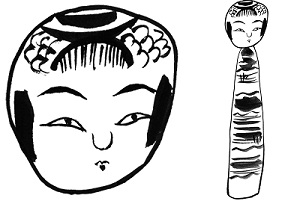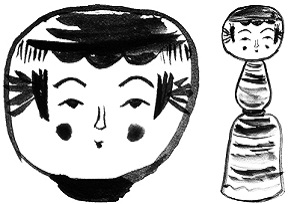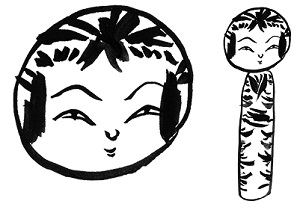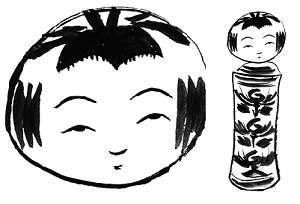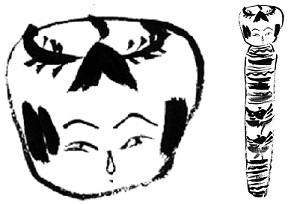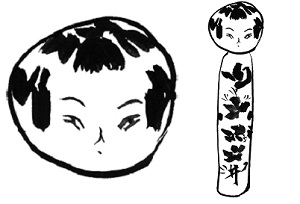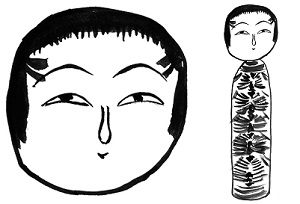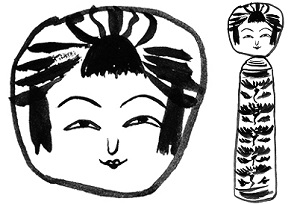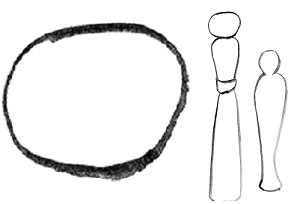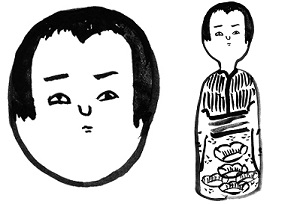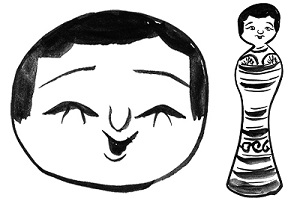
 |
 |
 |
 |
 |
 |
 |
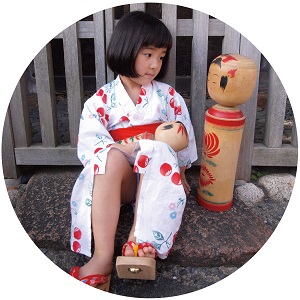

Kokeshi is a wood doll of the traditional craftwork
that was born and raised in the Northeast districts in Japan.
Read more about Kokeshi
*Click anywhere below to fold again*
It is said that the Kokeshi craftsmen originally made their living by producing wood miscellaneous devices such as bowls and trays a long time ago and some of them in Togatta area in the current Miyagi Pref. began making Kokeshi in the early 1800s.
It was the times in the Edo period when custom of "hot spring cure" spread among the rural farmers in their spare time. In the meantime, they came to sell Kokeshi as a souvenir for the hot spring visitors. The wood dolls were some cheap souvenirs for a little children those days.
Times changing from Meiji to Taisho era, Kokeshi was pushed away by the plastic dolls which came over from overseas and dying out as the outdated toy.
However, some Showa people who had an eye for the picturesque rediscovered Kokeshi's beauty and made the first Kokeshi-boom around 1935.
After the Discover-Japan-boom in the 1970' including 2nd Kokeshi-boom, we are now in the 3rd Kokeshi-boom. Recently, Kokeshi is in a trend as a Japan-traditional art and is popular especially among young ladies.
*Click anywhere above to fold again*
![]()
It is classified into the following 11 names by production center and characteristic.
Click Kokeshi icon to read that style.
|
TSUCHIYU style FUKUSHIMA
|
YAJIRO style MIYAGI |
TOGATTA style MIYAGI
|
NARUKO style MIYAGI
|
|
SAKUNAMI style MIYAGI
|
YAMAGATA style YAMAGATA
|
ZAO style YAMAGATA
|
|
|
NANBU style AKITA |
TSUGARU style AOMORI |
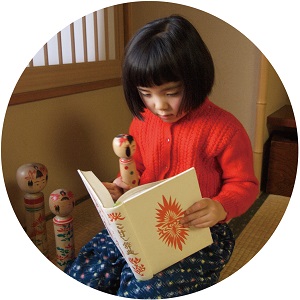

We published a magazine, "Kokeshi Jidai こけし時代" for the Kokeshi fans. We did it for the purpose of rediscovering the beauty of wood dolls, the simple and traditional craft-arts and restoring the paper magazine.
![]()
Read more about Kokeshi Jidai
*Click anywhere below to fold again*
Tohoku districts, home of Kokeshi, were damaged by 3.11 Earth quake and Tsunami. We believe that Kokeshi Jidai will bring smiles to Tohoku and that Kokeshi-Smile should be the one that is needed for the world as well.
We know that the paper magazine specialized in Kokeshi is quite new and experimental, but we aim at the handmade magazine like as the kokeshi dolls make people feel relieved with nostalgia. We hope that the readers will enjoy a feel of paper and smell of ink apart from PC, and have a nice kokeshi-trip in our magazine.
This magazine features the production areas and the hot springs of each kokeshi based on "active craftsmen", "on-site-report", and "present progressive". We visit each craftsman's site and report our journey so that readers would like to travel, to see, and to know there, too.
Kokeshi production areas are also the hot spring spot. We introduce the hot spring houses, souvenirs, local cakes, and tea shops as a travel book along with the articles such as Kokeshi-essay, Kokeshi-friends, Kokeshi-nostalgia, and Kokeshi-girls.
Therefore, Kokeshi Jidai is a good magazine for a variety of fans of Travel, Hot spring, Fork art, and Local train, Photograph etc. as well as Kokeshi fans.
![]()
*Click anywhere above to fold again*

From Tsuchiyu, Gaku, Iizaka and Nakanosawa hot springs, Fukushima Pref.
It has small head on the thin body painted by the horizontal lines as Yajiro style has, but Tsuchiyu Kokeshi has cuteness and astringency together.
Iizaka and Nakanosawa products are a little bit different form other Tsuchiyu styled dolls.
![]()
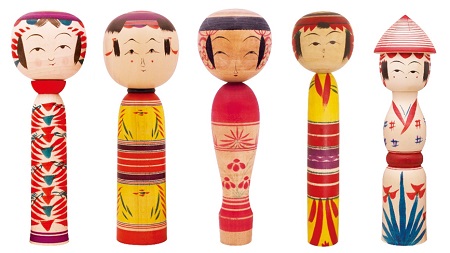
From Yajiro, Shiroishi city, Miyagi Pref.
They were a souvenir of Yamasaki hot spring in Yajiro.
A design like a beret or scarf and a variety of colored lines are the most beautiful. It looks like a fashionable woman wearing a skirt with rouge on her cheeks.
![]()

From Togatta hot spring, Miyagi Pref.
Some Kokeshi are from Aone or Akiu, too. Big head with hair-ornament-cloth and colorful designs such as Chrysanthemums, Cherry blossoms, wood grain patterns on the body are all lovely.
Their fascinating look is the extreme of the beauty of Kokeshi.
![]()
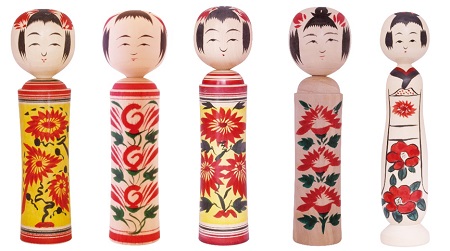
From Naruko hot springs, Miyagi Pref.
Turning in the neck fit in the body, it makes a creaky sound.
A chrysanthemum pattern is drawn on the body. This is a production area has the largest number of craftsmen, and many Kokeshi shops stand in the hot spring town. A famous Kokeshi collector says that “Kokeshi begins and ends in Naruko”.
![]()
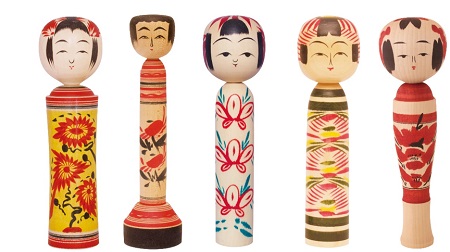
From Sakunami hot springs and some places around Sendai, Miyagi Pref.
It is said that that is the oldest Kokeshi production area according to the old documents. The thin body part shows that children played holding it those days.
Chrysanthemum is painted like as walking crabs. Kokeshi moved to Sendai is painted with red and black only.
![]()

From Yamagata city, Yamagata Pref.
Each house has individuality with different shapes and paintings. They were included in Sakunami originally.
It is now categorized as Yamagata style because they have more sophisticated taste while being developed in a city instead of the mountain villages.
![]()
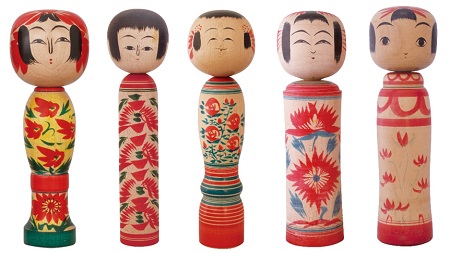
From Zao, Kaminoyama and Atsumi hot springs, Yamagata Pref.
It came from Togatta area, but came to be as the original style of Zao due to its thick and massive. The Chrysanthemums and cherry blossoms are painted on the body. Bob-haired girl looks intelligent.
![]()
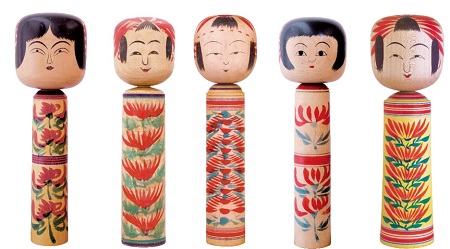
From Hijiori hot springs, Yamagata Pref. There are some in Sendai, too.
It’s a kind of hybrid Kokeshi made with the style of Naruko and Togatta being made in Meiji Era.
Chrysanthemums and Dianthus patterns are drawn on the yellow painted body. There is atmosphere of rustic girls in a hot spring village in the most mountainous place.
![]()
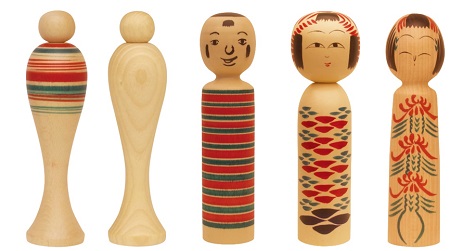
From Morioka, Hanamaki, Miyako, Iwate Pref. Nuruyu hot springs, Aomori Pref.
Bare Kokeshi show that they have been developed from the children's pacifiers and it is called “Kina Kina”.
Rickety head also shows that children played with them. Besides that type, there are other types coming from Naruko or Togatta area.
![]()
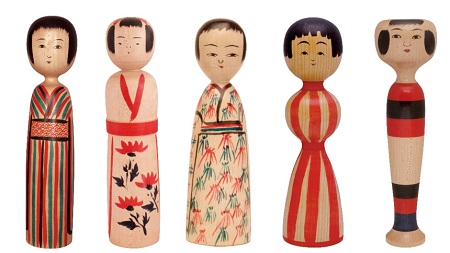
From Kijiyama, Kawazure, Yuzawa and Oyasukyo, Akita Pref.
Head and body are built in. Kimono pocket and sleeve are painted along with Chrysanthemum and plum patterns on the front. Those Kokeshi look as if mountain girls are staring still this side.
![]()
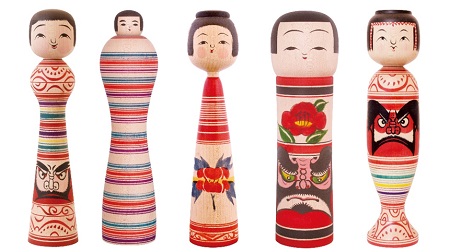
From Nuruyu hot springs, Aomori Pref.
Each house has individuality with different shapes and paintings. They are strongly influenced by Nebuta and Ainu taste.
Its head and body are made in a block mostly, but some Tsugaru Kokeshi have the head fit in the body like as Naruko Kokeshi.
![]()
![]()
